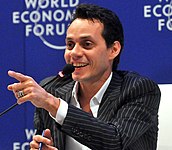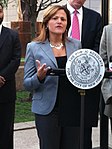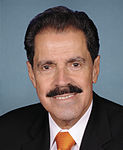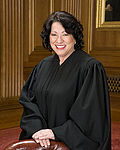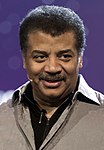Nuyorican
This article needs additional citations for verification. (February 2016) |
| Total population | |
|---|---|
| Nuyoricans 1,112,123 Americans (2017)[1] 23.15% of nationwide Puerto Rican population in 2010 5.5% of New York state population in 2010[2] | |
| Regions with significant populations | |
| New York City, New York | |
| Languages | |
| American English (Puerto Rican and New York Latino English), Puerto Rican Spanish, Spanglish | |
| Religion | |
| Predominantly Roman Catholic and Protestant |
| Part of a series on |
| Hispanic and Latino Americans |
|---|

Nuyorican is a portmanteau word blending "New York" (or "Nueva York" in Spanish) and "Puerto Rican," referring to Puerto Ricans located in or around New York City, their culture, or their descendants (especially those raised or currently living in the New York metropolitan area). This term is sometimes used for Puerto Ricans living in other areas in the Northeastern US Mainland outside New York State as well. The term is also used by Islander Puerto Ricans (Puerto Ricans from Puerto Rico) to differentiate those of Puerto Rican descent from the Puerto Rico-born.
The term Nuyorican is also sometimes used to refer to the Spanish spoken by New York Puerto Ricans. An estimated 1,800,000 Nuyoricans are said to live in New York City, the largest Puerto Rican community outside Puerto Rico. Nuyoricans are not considered Puerto Ricans by some island Puerto Ricans due to cultural differences, which remains a point of controversy among both groups of Puerto Ricans.[3] Despite the controversial label of “Nuyorican” the histories of New York, and Puerto Rico are undeniably intertwined. An infamous example of this would be the Puerto Rican Flag which was created in 1895 New York by Juan de Mata Terreforte along with 59 other exiled independistas.[4] Nuyorican has a broad meaning; originally it meant Puerto Ricans, both island-born and mainland-born, living in New York, but many island-born Puerto Ricans use the term to describe assimilated Americans of Puerto Rican descent living in any US state, or very assimilated people of Puerto Rican ancestry who may be more culturally aligned with African Americans, though still identifying as Puerto Rican.[5] Ethnic enclaves centered on Puerto Ricans include Spanish Harlem, Manhattan; Williamsburg, Brooklyn; Bushwick, Brooklyn; and the South Bronx.
Although Florida has received some dispersal of the population, there has been a resurgence in Puerto Rican migration to New York and New Jersey primarily due to economic and cultural considerations,[6][7] topped by another surge of arrivals after Hurricane Maria devastated Puerto Rico in September 2017. Consequently, the New York City metropolitan area has witnessed a significant increase in its Nuyorican population, individuals in the region of Puerto Rican descent, increasing from 1,177,430 in 2010 to a Census-estimated 1,494,670 in 2016,[8] maintaining New York's status by a significant margin as the most important cultural and demographic center for Puerto Ricans outside San Juan.
Etymology
[edit]The Oxford English Dictionary cites this word as evolving slowly through roughly the last third of the 20th century, with the first cited reference being poet Jaime Carrero using neorriqueño in 1964 as a Spanish-language adjective combining neoyorquino and puertorriqueño. Many other variants developed along the way, including neoricano, neorican (also written as Neo-Rican and Neorican), and newyorican (also written as New Yorrican). Nuyorican itself dates at least from 1975, the date of the first public sessions of the Nuyorican Poets Café. Some of the best known "Nuyoricans" who have written and performed their experiences of being a Puerto Rican in New York are: Miguel Piñero, Miguel Algarín, Piri Thomas, Sandra María Esteves, Willie Colón, Pedro Pietri, and Giannina Braschi.[9] Some of the newer poets include Willie Perdomo, Flaco Navaja, Nancy Mercado, Emanuel Xavier, Edwin Torres, J.L. Torres, Caridad de la Luz aka La Bruja, Lemon Andersen, and Bonafide Rojas.[[[10]]]
Historically, the term has been used as a derogatory term by native Puerto Ricans when describing a person that has Puerto Rican ancestry but is born outside of Puerto Rico.[11] It also can sometimes include those born in Puerto Rico who now live elsewhere in the United States (other than New York). This changed from the original meaning with the increase in travel back and forth to different parts of the United States and the globe. The definition includes those born in New York who have moved to Puerto Rico as well.[12]
The term is used by some members of this community to identify their history and cultural affiliation to a common ancestry while being separated from the island, both physically and through language and cultural shifts. This distance created a dual identity that, while still somewhat identifying with the island, recognizes the influences both geography and cultural assimilation have had.[13] Puerto Ricans in other cities have coined similar terms, including "Philly Rican" for Puerto Ricans in Philadelphia, and "Chi-Town Rican" for Puerto Ricans in Chicago.
History
[edit]Many Nuyoricans are second- and third-generation Puerto Rican living in mainland USA whose parents or grandparents arrived in the New York metropolitan area during the Gran Migración (Great Migration). Puerto Ricans began to arrive in New York City in the nineteenth century but especially following the passage of the Jones-Shafroth Act on March 2, 1917, which granted U.S. citizenship to virtually all Puerto Ricans.[14] The Gran Migración accelerated migration from Puerto Rico to New York during the 1940s and 1950s, but such large-scale emigration began to slow by the late 1960s.[15] Due to this large scale immigration there is a huge Puerto Rican influence that can be felt throughout New York. For instance along with African Americans, Puerto Ricans have had a major influence on popular genres of music such as Hip-Hop,[16] which is a genre of music originating out of the inner city neighborhoods of New York. Another significant contribution is the infamous Puerto Rican Day Parade which has its origins in 1958 Spanish Harlem.[17]
In 2000, the Puerto Rican population of New York was over 1,050,000.[18] As of the 2010 census, Puerto Ricans represented 8.9 percent of New York City alone (32% of the city's Hispanic community), and 5.5% of New York State as a whole.[19] Of over a million Puerto Ricans in the state, about 70% are present in New York City, with the remaining portion spreading increasingly within the city's suburbs and other major cities throughout New York State. Although Florida has received some dispersal of the population, there has been a resurgence in Puerto Rican migration to New York and New Jersey, primarily for economic and cultural considerations,[6][20] topped by another surge of arrivals after Hurricane Maria devastated Puerto Rico in September 2017 – consequently, the New York City Metropolitan Area has witnessed a significant increase in its Nuyorican population, individuals in the region of Puerto Rican descent, increasing from 1,177,430 in 2010 to a Census-estimated 1,494,670 in 2016.[8]
Historically, Nuyoricans resided in the predominantly Hispanic/Latino section of Upper Manhattan known as Spanish Harlem, and around the Loisaida section of the East Village, but later spread across the city into newly created Puerto Rican/Nuyorican enclaves in Brooklyn, Queens, and the South Bronx. Today, there are fewer island-born Puerto Ricans than mainland-born Puerto Ricans in New York City. Even though Puerto Ricans are one of the most prevalent ethnic groups in New York City, Americans weren’t always so welcoming to their Nuyrorican neighbors. Aside from the racism that Puerto Rican migrants experienced upon moving into the Tri-state area,[21] the U.S government ran a series of eugenicist campaigns throughout the first half of the 20th century known today as La Operación aimed at decreasing the Puerto Rican population on both the Island, and within the states (especially New York).[22] Under these campaigns countless Puerto Rican women were sterilized after being pressured from health care providers or even without their consent. Due to the effectiveness of this campaign its estimated that by 1956, 1 in 3 Puerto Rican women were sterilized.[23]
Prominent figures of the Nuyorican movement include poets and novelists Piri Thomas, Julia de Burgos and Giannina Braschi, while Miguel Algarín, Miguel Piñero, and Pedro Pietri co-founded the Nuyorican Poets Café, a performance space for Nuyorican poets and musicians.[24]
Notable Nuyoricans
[edit]- Nuyoricans
Nuyoricans have made breakthrough contributions in government, science, law, culture, and the humanities, including those who have broken records, significantly impacted U.S. pop culture, won landmark cases that changed laws, or have been recognized by national awards.
- Big Pun – Rapper
- Adrienne Bailon – Emmy Award-winning presenter, actress, and singer
- Eugenio Alvarez – Late U.S. representative from New York State.
- Al Diaz – Graffiti artist and component of SAMO alongside his friend, Jean Michel Basquiat.
- Carmelo Anthony – Basketball player
- Marc Anthony – Record holder in the Guinness World Record for best-selling salsa artist and the most number-one albums on the Billboard Tropical Albums charts.[25][26]
- Amanda Ayala – Singer/Songwriter
- Arturo Alfonso Schomburg – Historian and Writer during Harlem renaissance.
- Herman Badillo – Late U.S. representative from New York State
- Jean-Michel Basquiat – Artist, whose painting Untitled (1982) sold for $110.5 million in 2017, a new record high for an American artist at auction.[27][28]
- Giannina Braschi – Writer, a National Endowment for the Arts Literature Fellow, published the first Spanglish novel Yo-Yo Boing![29][30]
- Miguel Braschi – Attorney, won the landmark legal case Braschi v. Stahl Associates Co. in the New York State Court of Appeals, which marked the first time state law recognized a gay couple as a family.[31][32]
- Irene Cara – Actress and singer
- John Carro – was the first Nuyorican to be named a judge on the NY State Supreme Court, Appellate Division.[33][34]
- Julia de Burgos- Puerto Rican poet, journalist, and educator.
- Luis Ferré-Sadurní is a journalist with The New York Times.[35]
- Willie Colon – trombonist, vocalist, composer, arranger, bandleader, producer
- Robert Garcia – late U.S. representative from New York State
- Daniel Hernandez – Rapper
- Kayel – Latin freestyle singer and frontman for TKA
- La India – Freestyle and Sals singer
- Little Louie Vega & Kenny Dope from Masters at Work
- J.I the Prince of New York – rapper
- George Lamond – Freestyle singer
- Lisa Lisa (Lisa Velez) – Freestyle singer
- Jennifer Lopez – performing artist, entrepreneur, and founder of Nuyorican Productions, made Forbes list of most powerful entertainers, with annual earnings in excess of US$52 million.[36]
- Ricky Vega – Former World Champion Professional Wrestler
- Rita Moreno – first Hispanic woman to receive an Oscar, and was an actress, singer and dancer.
- Lynda Lopez – journalist and author
- Sonia Manzano – multiple Emmy winner, actress, screenwriter, author, singer, and songwriter.
- Margarita López – first openly lesbian councilwoman and female Puerto Rican elected to the New York City Council, serving from 1998 through 2006
- Melanie Martinez – Puerto Rican American singer-songwriter born in Astoria, Queens, NY
- Melissa Mark-Viverito – Speaker of the New York City Council from 2014 through 2017
- Angie Martinez – Rapper and radio host
- Lisette Melendez – Freestyle singer
- Rosie Méndez – former member of the New York City Council (2006-2018)[37]
- Lin-Manuel Miranda – creator of the Broadway musical Hamilton, won the Pulitzer Prize in Drama.[38]
- Nicholasa Mohr – Author
- Richie Narvaez – Author
- Alexandria Ocasio-Cortez – politician who serves as the U.S. representative from New York's 14th congressional district.[39]
- Antonio Pagán – late and first openly gay male and Puerto Rican elected to the New York City Council, serving from 1994 through 1998; former New York City Commissioner of Small Businesses (1998–2002)[40]
- Noel Pagán – Freestyle singer
- Eddie Palmieri – multi-Grammy winning pianist, bandleader, NEA Jazz Master
- Rosie Perez – Actress and choreographer
- Damian Priest – professional wrestler
- Tito Puente – multi-Grammy winning timbalero, composer, arranger, bandleader
- Princess Nokia – rapper
- Charles Rangel – former U.S. representative from New York
- Sylvia Rivera – Late LGBT rights activist
- Mj Rodriguez – Actress
- David Rosado – former U.S. representative from New York
- Sa-Fire (Wilma Cosmé) – Latin freestyle singer
- Bobby Sanabria – multi-Grammy nominated drummer, percussionist, bandleader, educator
- José E. Serrano – former U.S. representative, serving multiple districts in New York State
- Sonia Sotomayor – the first Nuyorican lawyer to become a United States Supreme Court Justice.[41][42]
- Cynthia Torres – Freestyle singer
- Edwin Torres – New York State Supreme Court judge and author of Carlito's Way
- TKA – Freestyle band
- Judy Torres – Latin freestyle singer and radio host
- Ritchie Torres – U.S. representative for New York's 15th congressional district
- Neil deGrasse Tyson – astrophysicist and television host of the PBS series Cosmos: A Spacetime Odyssey and Cosmos: Possible Worlds. He is the first person of Puerto Rican descent to be Director of the Hayden Planetarium in New York City.
See also
[edit]References
[edit]- ^ https://factfinder.census.gov/faces/tableservices/jsf/pages/productview.xhtml?pid=ACS_15_1YR_DP05&prodType=table=American Archived 2020-01-22 at archive.today, United States Census Bureau. Retrieved February 20, 2019.
- ^ "2010 Census". census.gov. 2010. Archived from the original on June 11, 2010.
- ^ The Nuyorican's Dilemma: Categorization of Returning Migrants in Puerto Rico
- ^ "The Flag of Puerto Rico | District of Puerto Rico | United States District Court". www.prd.uscourts.gov. Retrieved 2024-11-21.
- ^ Meraji, Shereen Marisol (January 22, 2014). "English Only? For Mainland Puerto Ricans, The Answer Is Often 'Yes'". NPR. Archived from the original on April 27, 2015. Retrieved April 3, 2018.
- ^ a b Cindy Y. Rodriguez (March 22, 2014). "Why more Puerto Ricans are living in mainland U.S. than in Puerto Rico". CNN. Retrieved March 22, 2014.
- ^ Dolores Prida (June 8, 2011). "The Puerto Ricans are coming!". New York Daily News. Retrieved March 22, 2014.
- ^ a b "Selected Population Profile in the United States, 2016 American Community Survey 1-Year Estimates". United States Census Bureau. Archived from the original on February 14, 2020. Retrieved September 22, 2017.
- ^ "Revista, Harvard Review of Latin America". 2000. Archived from the original on 2015-07-03. Retrieved 2015-07-02.
Giannina Braschi, a celebrated member of the Nuyorican Poets group
- ^ "Bonafide Rojas".
- ^ "The Unlinking of Language & Puerto Rican Identity". The Library of Congress. 22 June 2017. Retrieved 4 June 2020.
- ^ "Héctor Olivencia rememora el pasado de gloria del BSN". El Nuevo Día (in Spanish). 2017-02-18. Retrieved 2020-08-01.
- ^ "Reconnecting The Circuit Of Puerto Rican Identity Through Music". NPR.org. 2 November 2014. Archived from the original on 8 January 2019. Retrieved 4 June 2020.
- ^ Jones-Shafroth Act Archived 2011-11-25 at the Wayback Machine, U.S. Library of Congress, accessed May 25, 2010.
- ^ The Gran Migración Archived 2017-01-20 at the Wayback Machine, Maura Isabel Toro-Morn, Marixsa Alicea, Migration and Immigration: A Global View.
- ^ Arroyo, Jossianna (2010). "'Roots' or the virtualities of racial imaginaries in Puerto Rico and the diaspora". Latino Studies. 8 (2): 195–219.
- ^ Wynne, Michael (2024-06-10). "A Brief History of the Puerto Rican Day Parade". Nuestro Stories. Retrieved 2024-11-19.
- ^ Atlas of Stateside Puerto Ricans: Abridged Edition without Maps. Archived 2019-04-12 at the Wayback Machine Angelo Falcon. Puerto Rico Federal Affairs Administration. ca. 2002. Page 3. Retrieved 13 December 2013.
- ^ "Hispanic or Latino by Type: 2010 Census Summary File 1". U.S. Census Bureau. 2011.
- ^ Dolores Prida (June 8, 2011). "The Puerto Ricans are coming!". New York Daily News. Retrieved March 22, 2014.
- ^ Kosuzu, Abe (7 January 2008). "Identities and Racism of Puerto Rican Migrants in New York City". Transforming anthropology. 14 (1): 83–88 – via AnthroSource.
- ^ Lopez, Iris (1993). "Agency And Constraint: Sterilization And Reproductive Freedom Among Puerto Rican Women In New York City". Urban anthropology and studies of cultural systems and world economic development. 22: 299–323.
- ^ Presch, Stephanie; UnidosUS (2021-12-16). "The long history of forced sterilization of Latinas". UnidosUS. Retrieved 2024-11-23.
- ^ 'Photographing Puerto Rican New York, With A 'Sympathetic Eye Archived 2015-02-27 at the Wayback Machine', NPR News, October 26, 2013.
- ^ "Marc Anthony Scores Guinness World Record". Billboard. Retrieved 2020-11-02.
The Latin superstar was awarded the title of the solo artist with most year-end best-selling albums on the Tropical Albums chart.
- ^ "Marc Anthony Just Beat a Guinness World Record". NBC News. 9 February 2016. Retrieved 2020-11-02.
- ^ Pogrebin, Robin; Reyburn, Scott (May 19, 2017). "A Basquiat Sells for 'Mind-Blowing' $110.5 Million at Auction (Published 2017)". The New York Times. ISSN 0362-4331. Retrieved 2021-01-12.
- ^ Dwyer, Colin (May 19, 2017). "At $110.5 Million, Basquiat Painting Becomes Priciest Work Ever Sold By A U.S. Artist". NPR. Retrieved 2021-01-12.
- ^ "About Giannina Braschi: Academy of American Poets". poets.org. Academy of American Poets. Retrieved 2020-11-02.
Her literary works include the Postmodern poetry classic Empire of Dreams and Yo-Yo Boing! credited with being the first novel to be written in Spanglish.
- ^ "Giannina Braschi". World Literature Today. Retrieved 2020-11-02.
- ^ "AIDS activists fought for public recognition. This exhibit shows their lives at home". PBS NewsHour. 2017-07-09. Retrieved 2020-11-02.
- ^ "The Braschi Breakthrough: 30 Years Later, Looking Back on the Relationship Recognition Landmark". Historical Society of the New York Courts. 2019-09-12. Retrieved 2020-11-02.
- ^ "Appellate Division – First Judicial Department". www.nycourts.gov. Retrieved 2020-11-02.
- ^ "The cosmos", Fusion, CRC Press, pp. 40–53, 1999-12-01, doi:10.1201/9781482268669-13, ISBN 978-0-429-17612-8, retrieved 2020-11-02
- ^ "Luis Ferré-Sadurní". The New York Times. Retrieved March 9, 2021.
- ^ "Jennifer Lopez". Forbes. Retrieved 2020-11-02.
The Latina performer may be the most powerful entertainer on the planet. She raked in an estimated $52 million last year with projects in almost every corner of the industry (fragrance, clothing lines, film and television).
- ^ "New York pols' coming out stories". CSNY. June 12, 2018.
- ^ "Documentary On HBO Provides A Look Into The Miranda Family". NPR.org. Retrieved 2020-11-02.
- ^ "Pearls of Resistance: Alexandria Ocasio-Cortez shares her skincare routine". 30 August 2020.
- ^ Chan, Sewell (26 January 2009). "Antonio Pagán, 50, Ex-Councilman, Is Dead". The New York Times. Retrieved April 20, 2021.
- ^ Stolberg, Sheryl Gay (2009-05-26). "Sotomayor, a Trailblazer and a Dreamer (Published 2009)". The New York Times. ISSN 0362-4331. Retrieved 2020-11-02.
- ^ "Sotomayor Shaped By Her 'Nuyorican' Roots". NPR.org. Retrieved 2020-11-02.
External links
[edit]- Sofrito For Your Soul Online Magazine
- Capicu Poetry & Cultural Showcase
- Celebrities Desde Nueva York
- The art of Santiago
- Association of Hispanic Arts (AHA)
- Nuyorican cinema
- Boricuation Cultural Foundation
- Soraida Martinez, New York born artist of Puerto Rican heritage known as creator of Verdadism
- "Nuyorican Power"

